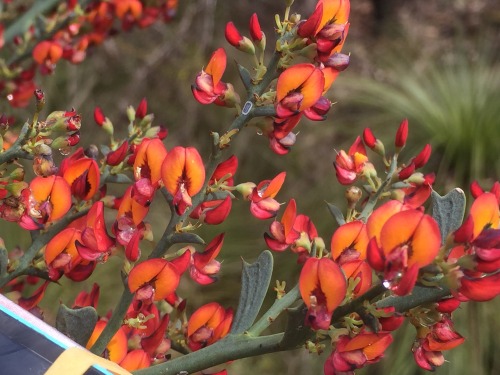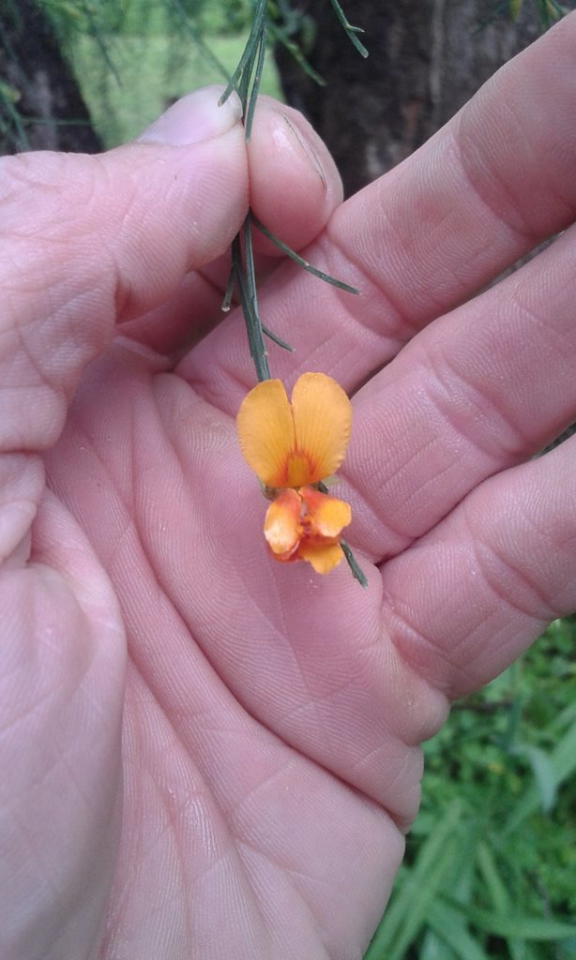#1719-1726 - Give Peas A Chance
#1719 - Daviesia physodes - Phoenix Bitter-pea



Another of Australia’s ludicrously diverse peas, and as you can probably guess the genus is most diverse in Western Australia. This particular species, which is one of over a hundred in the genus (named after the Welsh botanist Hugh Davies), grows from Geraldton to Augusta.
Those aren’t leaves, by the way, but tough flattened stems that serve the same purpose. It’s a common drought adaption among Australian plants.
#1720 - Daviesia sp. - Bitter-pea



A different Daviesia, this one with true leaves, but with the same defences used by many Australian shrubs - i.e. a propensity to stab the f*** out of you.
This one was growing in Hammond Park, in Perth, rather than down south, but if I’m going to cover the diversity of Australian peas, which I’ve somehow managed to almost entirely miss over the years, I may as well start with one in the same genus as the Phoenix Bitter-Pea.
#1721 - Hovea trisperma - Common Hovea

Named after Anton Pantaleon Hove, collector of plants for Kew on the West African coast, in the Crimea and India, and the 3-celled ovary, when 2- or 4-celled ovaries is the norm for the genus.
A perennial short stemmed woody shrub 10 to 70 centimetres tall, but happy to start flowering before it’s even 10cm tall. They were certainly doing so down at Yallingup.
Native to south-west Western Australia. The flowers are blue or purple (or very rarely white) and appear between May and November. The seedpods are distinctly odd-looking, as you can see in the second photo.

#1722 - Jacksonia furcellata - Grey Stinkwood


A species of leafless broom-like small tree in the pea family, native to the south west of Western Australia. Like most Jacksonias, it has rigid branches, and leaves reduced to small scales at best. There’s about 40 species in the genus, found only in Australia, and, you guessed it, most are found in WA.
One of the most common plants of the Swan Coastal Plain, it is an enthusiastic colonizer of newly cleared land (such as my backyard). It is often seen growing where soil has recently been disturbed, such as alongside new roads (or my backyard - at least until it died and fell over).
#1723 - Jacksonia sternbergiana - Green Stinkwood



Named after George Jackson (1780 - 1811) a Scottish botanist, and Bohemian botanist and museum patron Caspar Moritz von Sternberg (1761 - 1838). The common name refers to why you should never use it in a campfire.
A small leafless tree, up to 5m tall, that occurs in the south-west of Western Australia. It has a weeping habit, and produces yellow and orange flowers in the summer. The Noongar peoples know the plant as Kabbur, Koorpa or Mondurn.
It’s the foodplant for a variety of Lycaenid butterflies, including the turquoise jewel, fringed heath-blue, and long-tailed pea-blue, but only if the right species of ant are around to stand guard.
#1724 - Viminaria juncea - Native Broom


Also known as Golden Spray or Swishbush. The Noongar peoples know the plant as koweda. Originally described in 1795 by Heinrich Adolf Schrader as Sophora juncea. The current binomial means “rush-like switch”.
Native Broom is the only member of its genus, and it grows wild in moist temperate parts of most States. In swamps it can it can grow in extensive stands, and into a tall loose shrub where crowded. Left to its own devices can grow a single trunk 6 m high, with dark fibrous bark.
It can be kept as a garden shrub, amenable to trimming.
Usually considered leafless, except on the youngest plants and stems but the leaves are in fact tiny scales and most of the plant consists of flattened, stringy, green stems up to 25 mm long.
It grows rapidly in many soil types, and light conditions, as well as being frost resistant. Honestly, it’s amazing more people don’t plant the stuff. In November the branches become thickly lined with small yellow pea flowers 1 cm long, smelling faintly of clover. Seed production is healthy, with one small bean per pod, easily propagated.
Ambergate Reserve, south of Busselton
#1725 - Mirbelia dilatata - Holly-leaved Mirbelia

Mirbelia is another Australian pea genus, with dozens of species, spread over all states with the curious exception of South Australia. This one is a SW WA endemic. Again.
It grows into an erect, spindly shrub 5 m tall, in the Darling Range on moist, heavy soils mainly to the south of Perth. ‘dilatata’ refers to the way the leaves spread out at the end.
#1726 - Eutaxia myrtifolia - Egg and Bacon Plant


A small shrub, up to 2m tall, that grows along the coast between Cape Nasturaliste and Cape Arid. Evergreen, with fleshy leaves, and flowering year-round. Quite reliable in cultivation, too. This one was growing among granite boulders overlooking Smiths Beach.